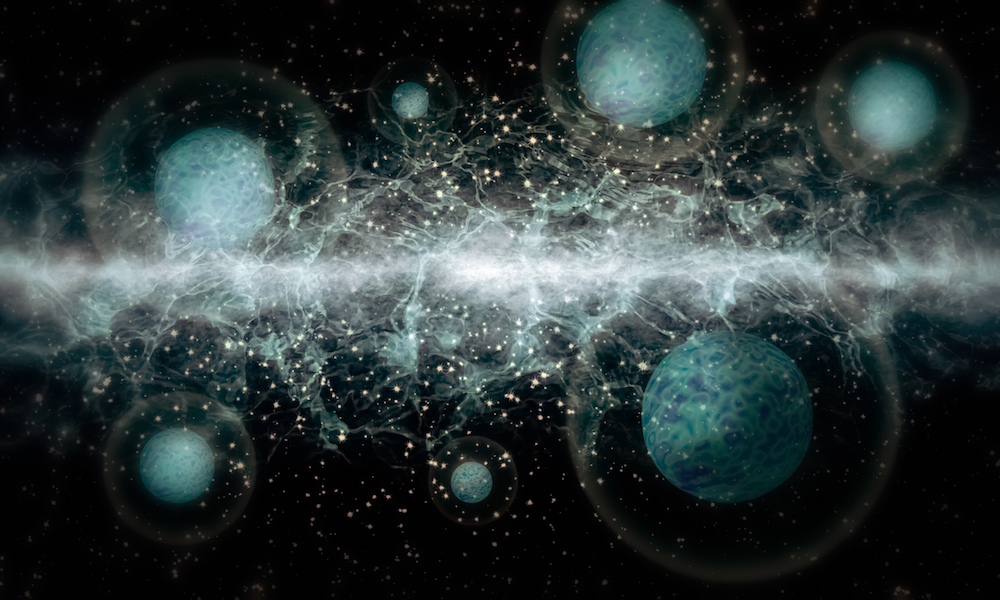Dark Photons Probably Don't Exist, and If They Did, They'd Be Super Weird

A new, ultraprecise measurement of a fundamental physical constant has so far found no hint of mysterious particles known as dark photons.
If they existed, these hypothetical shadowy twins of ordinary light particles would be one way to explain the presence of dark matter, a mysterious form of matter that emits no light yet exerts a gravitational pull.
But the most precise measurement yet of the fine structure constant — which determines how strongly electrons and photons interact, or "couple" — has eliminated the possibility of dark photons at a large range of masses and coupling strengths. If they did exist, they would have to be much heavier than previously predicted, scientists wrote in a new paper describing the work.
"Our measurement rules out these dark photons very strongly," said University of California, Berkeley physicist Holger Müller, one of the co-authors of the new paper.
By mixing with regular photons, dark photons could theoretically be detected, because the mixing would have an effect on the fine structure constant. But in this new, exact measurement of the constant, evidence of the dark photon was nowhere to be found.
Measuring the fine structure constant
Physicists use the Standard Model, which describes the physics of subatomic particles such as electrons and photons, to predict the value of the fine structure constant. First, however, they need to know a physical property of the electron: its magnetic moment. Previous measurements of the constant have used indirect prediction by combining Standard Model predictions with experiments that measure this magnetic moment. The new study takes a more direct approach.
To do this, the researchers made a tiny "atomic fountain" of cesium atoms. Atoms were launched upward in a single stream and then were hit with lasers to force them into a quantum superposition, in which each cesium atom was in two places at the same time. This made two streams, paradoxically made of the same atoms. When the two streams of cesium atoms were recombined, the atoms interfered with themselves in just the right way for scientists to calculate the atoms' velocity when they were hit by the photons in the laser. Because the speed reveals how much force these atoms were hit with, and thereby how strongly photons and electrons "couple," the fine structure constant could be calculated to unparalleled precision, the researchers reported April 13 in the journal Science. [Strange Quarks and Muons, Oh My! Nature's Tiniest Particles Dissected]
Get the world’s most fascinating discoveries delivered straight to your inbox.
But what does this have to do with dark photons?
Dark photons
If the dark photon exists, it would be an electromagnetic force carrier, like the photon. But instead of working between charged particles of regular matter, like a photon does, the dark photon would enable electromagnetic interactions between particles of dark matter. [The World's Most Beautiful Equations]
Dark photons don't fit into the Standard Model. So, if they really exist, real-life measurements wouldn't match up with predictions made by the Standard Model. Specifically, the direct measurement of the fine structure constant should differ from the previous values derived from indirect measurements andthe Standard Model, said Müller.
The new research did find a different value of the fine structure constant than the Standard Model predicts, which might suggest that dark photons exist. But there's a catch.
The disagreement they found "is in the opposite direction of what you'd expect if the dark photon exists," Müller told Live Science. "It's disagreement, but it's the wrong way."
However, there's still a narrow escape path, through which theoretical dark photons could escape the dustbin of discarded physics theories. The field of particle physics has a general standard for measuring the significance of results: Typically, a truly significant resultmust have less than a 1-in-3.5-million probability of being due to random chance, which is a "5-sigma" level of significance. In this case, the difference between this measurement and the previous most-precise measurement is only a "2.5-sigma" level of significance, or a 1-in-200 probability of being due to random chance — far too likelyto meet thestrong standard of the field.
"It's too far off to call it agreement, but not far enough to call it significant disagreement," Müller said, calling it "almost a gray area."
But at this point, it may not matter. If the measurements agree, that severely limits the possibilities for dark photons. If the measurements disagree, the disagreement is in the wrong direction — and that, Müller said, is also powerful evidence against them.
"It's like you think someone stole your money, and then when you look in your wallet, you find you have more money than you did before," Müller said.
Originally published on Live Science.


